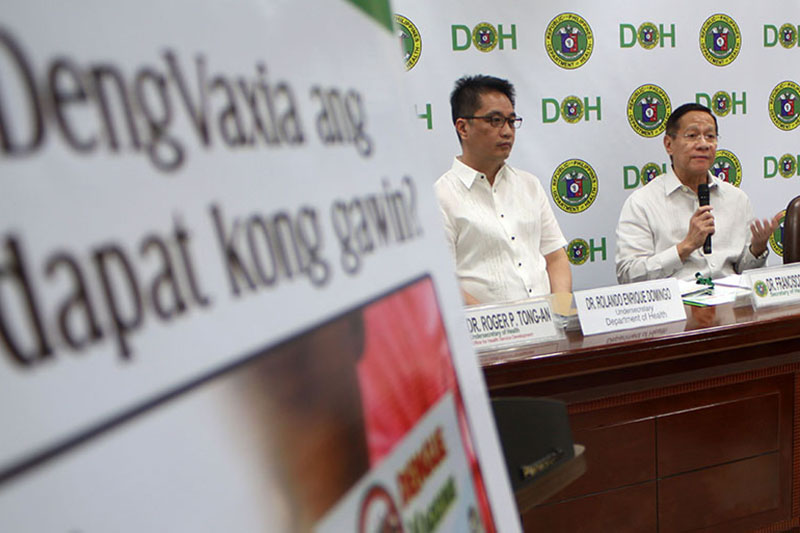A NEW study confirmed that the world’s first dengue vaccine, which was given to over 800,000 school children in the Philippines, poses risks of hospitalization and severe sickness in those who have not been infected by the virus before getting vaccinated.
Now, the Philippine government hopes the new study will help amplify its demand for a full refund from the controversial Dengvaxia maker Sanofi Pasteur.
“Sanofi has rejected the DOH’s [Department of Health’s] request for a full refund multiple times now, refusing to pay the Philippine government back for the vaccines already used. But all Dengvaxia has given is grief and anger to us Filipinos who unfortunately served as guinea pigs,” said House Committee on Appropriations chair, Karlo Nograles, on Monday, June 18.
“The Philippines through the DOH has more leverage than ever to seek the refund,” Nograles added.
The study published in the New England Journal of Medicine (NEJM) last week confirmed a WHO recommendation made in April that Sanofi’s dengue vaccine should not be administered without testing for prior dengue infection.
The problem was first revealed in November when Sanofi Pasteur, after analyzing blood samples of thousands of vaccinated children, warned that its Dengvaxia vaccine could in fact increase the risk of severe dengue, prompting an investigation by the Philippine government.
Sanofi received backlash by experts who said the company and its regulators dismissed the vaccine’s warnings and risks, despite knowing about them as early as 2015.
The NEJM study’s authors said that their findings supported the hypothesis that in the absence of previous dengue exposure, Dengvaxia “partially mimics primary infection and increases the risk of dengue.”
Included in the study were 2,384 children who were vaccinated with Dengvaxia, and 1,194 who were not.
The study found that if given to one million children over the age of nine, the vaccine could prevent 11,000 hospitalizations and 2,500 severe cases of dengue. It could also though lead to 1,000 hospitalizations and 500 severe dengue cases in children who had not been previously infected.
The study’s data also found that there was a significantly higher risk of hospitalization among uninfected children aged 2 to 8 who had received the vaccine. There was also a trend towards increased hospitalization among those aged 9 to 16.
For children aged 9 and older who were previously exposed, rates of severe dengue and hospitalization were reduced 80 percent by the vaccine in comparison to the control group.
“The published findings confirmed Sanofi’s belated admission of the pitfalls of Dengvaxia,” said Nograles. “It also upheld the World Health Organization recommendation last April that the vaccine should not be used without testing for prior dengue exposure.”
Nograles said that the new findings should further motivate the Senate to approve its own version of a proposed P1.16 billion supplemental budget meant to extend medical assistance to Dengvaxia recipients. The amount comes from the P1.6 billion refunded by Sanofi Pasteur early in the year.
The Philippine House of Representatives approved its version on a third reading in May.
Based on the House version, the money would go towards aiding programs like the Medical Assistance Program, assisting admitted patients and outpatients, assessing and monitoring those who received Dengvaxia vaccines, supplies and medicine, and human resource deployment.
ASEAN dengue problem
About half of the world’s population is at risk of getting dengue, a mosquito-borne viral infection that can lead to flu-like illnesses and even death. But the ASEAN region, home to tropical and subtropical climates, is the most seriously affected according to the World Health Organization.
More than 425,000 people in the ten member state region had been hit by dengue last year alone — a number higher than any region in the world. In the Philippines, health officials said the first five months of 2017 recorded nearly 41,000 dengue fever cases. By the end of the years, 732 had died.
This year’s numbers covering the same time period have reportedly shown a seven percent decrease, but officials say they still have much to worry about.
In the five month period, 195 deaths were recorded. Most affected were 10 to 14 year olds with males making up 52 percent of all cases.
Areas with the highest number of cases were National Capital Region (6,493 cases), CALABARZON (6,296), Central Luzon (5,997), Northern Mindanao (2,540), Western Visayas (2,314), and Central Visayas (2,241).
“Our goal to prevent dengue starts within ourselves by maintaining cleanliness in our surroundings by emptying containers of stagnant waters to eliminate breeding places of Aedes Aegypti mosquitoes,” said Health Secretary Francisco T. Duque III.
He added that the DOH’s 4S Kontra Dengue strategy is effective in helping prevent illness and deaths. The strategy requires searching and destroying mosquito breeding areas, securing self-protection, seeking early consultation, and spraying mosquito hotspots that have been registered as having increasing cases for two consecutive weeks.
Health Undersecretary Rolando Enrique Domingo said that at least three dengue experts from the WHO will be visiting the Philippines next week to train doctors, and look into the needs of some major hospitals to help them become dengue speciality centers.
This comes as other ASEAN nations also buckle down on dengue fighting initiatives. This year marks the eighth year of ASEAN Dengue Day which has been observed every June 15 since its inception by ASEAN nations and the WHO in 2010.






